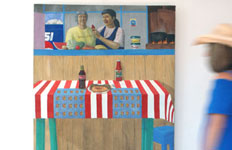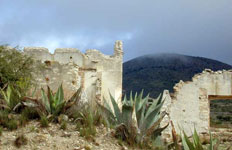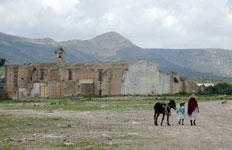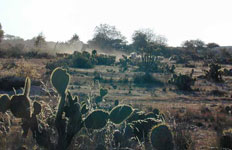About La Colección Chichimeca
Painting: Subversive art in a generic world
Several emotions inspire the Coleccion Chichimeca. One is the sadness caused by the way painters seem to be viewed today as the poor relatives of the contemporary art world. Another is a nostalgia for museums brimming with rich collections of paintings. But the greatest inspiration by far, is the joyous vibrancy, the vital freshness of today's Latin American painting.
That painting nowadays must compete with other arts forms does not really explain why most contemporary paintings exhibited today tend to be “Bad Painting” rather than simply good painting. What's more, good paintings seem to unleash sarcastic reactions, as if mastery of the craft were somehow shameful. This contempt for talented painters is all the more perplexing if we recall that since the caves of Pech Merle twenty-five thousand years ago, painting has been one of mankind's most enduring trademarks.
Such estrangement from the medium is revealing of the world in which we now live. From a cultural standpoint globalization's most perverse effect has been an insidious march toward uniformity. Unsurprisingly, the main casualty has been identity - whether personal, regional or national – unless of course such identity be packaged into exotic tourist destinations or gadgets distributed on the world wide web.
The avowed objective of globalization's captains is to make the most efficient use of any available technology to sell more, faster and further afield. The implicit requirement for the success of such enterprise however, is that people be alienated from their past, their present, their surroundings, their culture - and their emotions as well.
The global village profoundly distrusts what Erich Fromm called the psychic “functions of passion” from which, as this psychoanalyst of Frankfurt rightly said, myths, religion, the yearning for freedom and art are born. The tidy generic culture promoted by globalization combats emotions and consequently, the creative freedom born of their “messiness.”
The present institutional hostility that surrounds painting underlines, if anything, that it is the least generic of the visual arts. A quintessentially intimate art, painting is rooted in the artist's imagination and nourished by his day to day experience of living. A suspiciously low-tech medium, painting translates inner sensations and personal emotions, marked by the subversive seal of individuality. Is it surprising then that painters seem like dissidents these days?
The current dismissal of the medium, however, has neither succeeded in discouraging true artists, nor has it dampened in any way the passion of the many lovers of painting. The Chichimeca Collection is an expression of this passion.
It celebrates in equal measure the refusal of Latin American painters to be the foot soldiers of unbridled acculturation, and also their talent, their love of the craft and the obvious pleasure they take in creating a new visual syntax.
The vast distance that separates most Latin American countries from global art centers may not work in the artists' favor financially, but it does artistically. It shelters them from the distractions of fleeting fashions and market pressures, and provides the necessary space to explore the wealth of the medium in peace.
As seen in the Chichimeca Collection, a new iconography is emerging, one that speaks of the multiple realities of this vast and diverse region. The themes of this Latin American Renaissance are soccer players, voodoo rituals, the noisy streets of Central America, its stray dogs and “foamy crowds”, as Nicolas Guillen called them with Caribbean tenderness.
The term Renaissance is not as outlandish as it seems. Whereas contemporary painting elsewhere seems often at odds with Man, his small joys and greater sorrows, Latin American painters put humanity at the center of their work. They bring back to the medium its most essential and compelling ingredient: interiority. And this alone is a promise of great things...
Lucía Méndez Rivas repeatedly tackles a difficult but uniquely human subject: religion, to be precise santería. Her brush reveals the curvaceous sensuality of the black santeras, their musky trances and mysterious rituals. Embracing her Afro-Caribbean roots, she subtly mixes exquisite draftsmanship and backgrounds of solid color to show the female body in its powerful and carnal monumentality.
With the mischief of a tender child, Mateo Argüello Pitt blurs the line between solitude and multitude, plays with full and empty with a light touch, and scatters paradox with daredevil insouciance. He legitimizes weight lifting, bungee jumping, tennis or soccer as themes of the craft. Under the brush of his compatriot Enrique Burone Risso, Buenos Aires undulates, full of twists and turns and curves - a theme park really - that reminds those of us who had an urban childhood how joyous a city can be.
With gentle irony the Venezuelan Miguel Meza makes light of human absurdity, but his impetuous and manly impasto reminds us of the voluptuousness of the medium at its best. Meanwhile, the naughty hamburgers that replace the stars on Mario Lanz’ American flag are not without innuendos, but the artist stays away from solemn statements, signing his work with a wink and a bar code.
Yes, violence unfortunately is part of Latin American reality and puzzles most the youngest artists of the collection: The defying gaze of the young girl in Sarah Lynn Pistorius’ Muro con Alma is chilling and unsettling. Cesar Chavez does not shy away from blood and pain, and Irving Herrera makes good use of the vaguely menacing idiom of his nights as graffiti artist. At the opposite end of the spectrum, Fabio Egea’s quasi Zen work brings us the hope that comes with serenity, whereas Carlos Quintana, faithful to his Cuban roots, uses the charcoal like a surgeon uses a scalpel -- with perfect precision.
While the planet anxiously monitors the NASDAQ and the Brent Crude Future, wondering if the next stock market crash will mean the end of its riches, Latin American painters are peacefully at work in their studios, increasing the artistic capital of humanity. It brings to mind Atahualpa Yupanqui’s popular song:
“Pobrecito mi patrón,
Piensa que el pobre soy yo¨.....
(“My poor little boss,
He thinks the poor one is me...”)
Gail Lusby
The Curator & Collector
|











